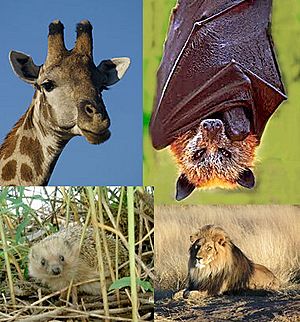Laurasiatheria facts for kids
Quick facts for kids LaurasiatheriaTemporal range: Upper Cretaceous – Recent
|
|
|---|---|
 |
|
| Clockwise from the upper left: giraffe, fruit bat, lion, hedgehog | |
| Scientific classification | |
| Kingdom: | |
| Class: | |
| Infraclass: | |
| Superorder: |
Laurasiatheria
Waddell et al., 1999
|
| Orders | |
Laurasiatheria is a large group of placental mammals. These are mammals that give birth to live young. The babies grow inside the mother's body.
This group gets its name from an ancient landmass. This landmass was a supercontinent called Laurasia. It was in the northern part of the world. Today, it roughly matches Eurasia and North America. Many advanced mammals first evolved here.
Long ago, the supercontinent Pangaea broke apart. It split into Laurasia in the north and Gondwana in the south.
Contents
What Animals Are Laurasiatheria?
This amazing group includes many different animals. You might know some of them!
For example, it includes tiny shrews and spiky hedgehogs. It also has unique pangolins and flying bats. Big whales are part of this group too. Most hoofed mammals like horses and cows belong here. Even carnivorans, like lions and bears, are Laurasiatheria.
How Scientists Define the Group
Scientists define Laurasiatheria using DNA sequence analysis. This means they look at the genetic code of animals. Animals in this group share similar DNA patterns.
They do not share any obvious physical features. This is why DNA is so important for grouping them. It helps scientists understand how different animals are related.
Main Groups of Laurasiatheria
The Laurasiatheria superorder includes several living orders. Each order contains different types of animals.
Eulipotyphla: Small Insect Eaters
This order includes small, often insect-eating mammals.
- Hedgehogs have spiny coats.
- Gymnures look like large shrews.
- Moles live underground.
- Shrews are tiny, mouse-like animals.
- Solenodons are rare, venomous mammals.
These animals can be found all over the world.
Cetartiodactyla: Hoofed Mammals and Whales
This is a very diverse group. It includes two main types of animals:
- Cetacea: This sub-group includes whales, dolphins, and porpoises. They are mammals that live in the ocean.
- Artiodactyla: These are even-toed ungulates. This means they have an even number of toes. Examples include pigs, hippos, camels, giraffes, deer, antelopes, cattle, sheep, and goats.
You can find these animals all around the world.
Pholidota: Scaly Anteaters
- Pangolins are also known as scaly anteaters. They are unique mammals covered in hard scales.
They live in parts of Africa and South Asia.
Chiroptera: The Flying Mammals
- Bats are the only mammals that can truly fly. They have wings made of skin.
Bats live in almost every part of the world.
Carnivora: Meat Eaters
- Carnivorans are mostly meat-eating mammals. This group includes many animals you know.
Examples are lions, tigers, dogs, cats, bears, and weasels. They are found all over the world.
Perissodactyla: Odd-Toed Ungulates
- Perissodactyla are odd-toed ungulates. This means they have an odd number of toes on each foot.
Examples include horses, rhinos, and tapirs.
How They Are Related
Scientists are still working to figure out the exact family tree of these groups. There are different ideas about how they are all connected. Experts continue to study their DNA and features. This helps them understand the evolutionary history of Laurasiatheria.
See also
 In Spanish: Laurasiaterios para niños
In Spanish: Laurasiaterios para niños

